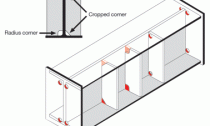Good design requires:
- means for the access and drainage of molten zinc
- means for escape of gases from internal compartments (venting)
It is important to bear in mind that the steelwork is immersed into and withdrawn from a bath of molten zinc at about 450°C. Thus any features which aid the access and drainage of molten zinc will improve the quality of the coating and reduce costs.
With certain fabrications, holes which are present for other purposes may fulfil the requirements for venting and draining; in other cases it may be necessary to provide extra holes for this purpose.
For complete protection, molten zinc must be able to flow freely to all surfaces of a fabrication. With hollow sections or where there are internal compartments, the galvanizing of the internal surfaces eliminates any danger of hidden corrosion during service.
General principles for filling, venting and drainage
1. Holes for venting and draining should be as large as possible. The minimum hole diameters are given in the table below.

- Holes for venting and draining should be diagonally opposite to one another at the high point and low point of the fabrication as it is suspended for galvanizing. Very long hollow sections may require additional vent holes to aid drainage and to help produce better surface finish.
- With hollow sections sealed at the ends, holes should be provided, again diagonally opposite one another, as near as possible to the ends. In some cases it may be more economical to provide V or U shaped notches in the ends, or to grind corners off rectangular hollow sections – these procedures provide ideal locations for venting and draining.
- Where holes are provided in end plates or capping pieces, they should be placed diagonally opposite one another, off centre and as near as possible to the wall of the member to which the end plate is connected.
- Internal and external stiffeners, baffles, diaphragms, gussets etc., should have the corners cropped to aid the flow of molten zinc.
Where venting of hollow section is required, for a longer section (e.g. >3m) there may be a need for additional or longer vent holes to help achieve the best possible surface finish. Advice should be sought from the galvanizer.
Holes that have been drilled for venting can be plugged, but this is mainly necessary for aesthetic reasons, because a galvanized coating covers all surfaces. If required, tapered aluminium or plastic plugs are available and will prevent undesirable ingress of water.
Detailed design advice is available from Galvanizers Association or directly from the galvanizer. For basic detailing for venting and drainage, refer to Points to consider when designing fabrications.

